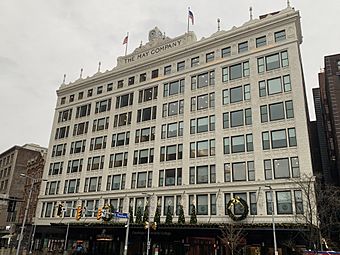May Company Ohio facts for kids
| Department store | |
| Industry | Retail |
| Fate | Merged into Kaufmann's |
| Successor | Kaufmann's (1993–2005) Macy's (2006–present) |
| Founded | 1898 |
| Defunct | 1993 |
| Headquarters | Cleveland, Ohio |
| Products | Clothing, footwear, bedding, furniture, jewelry, beauty products, and housewares. |
|
May Company
|
|

Front of the building
|
|
| Location | 158 Euclid Ave. at Public Sq., Cleveland, Ohio |
|---|---|
| Area | 1.8 acres (0.73 ha) |
| Built | 1914 |
| Architect | D.H. Burnham & Co.; Graham, Anderson, Probst & White |
| Architectural style | Chicago |
| NRHP reference No. | 74001443 |
| Added to NRHP | January 18, 1974 |
The May Company Ohio was a famous chain of department stores. It was based in Cleveland, Ohio, in the United States. These stores sold many different kinds of products.
Contents
How The May Company Started
The May Company started in 1899. A man named David May bought a store in Cleveland. It was called E. R. Hull & Dutton Co. He changed its name to May Company, Cleveland.
In 1914, the company added a large, new building. It was on Euclid Avenue in downtown Cleveland. This building was 149 feet tall. It had 8 floors, but the top two floors were added later in 1931.
Growing The Business
The May Company grew bigger over the years. In 1939, it took control of another Cleveland store. This store was called William Taylor Son & Co. It kept its own name until 1961.
The company started opening stores in the suburbs in the 1950s.
- In 1953, a store opened in Sheffield Shopping Center in Lorain.
- In 1956, a store opened in Cedar-Center Plaza in University Heights. People called it "May's on the Heights."
- In 1960, a branch opened at Parmatown Mall in Parma.
- In 1961, another store opened at Southgate Shopping Center in Maple Heights.
More mall stores opened in the 1960s and 1970s. These included stores at Great Lakes Mall (1964), Great Northern Mall (Ohio) (1965), Randall Park Mall (1976), Euclid Square Mall (1977), and Sandusky Mall (1979).
What The May Company Sold
The May Company sold many items. They focused on mid to higher-end fashion and home goods. This included clothing, shoes, bedding, furniture, and jewelry. Their prices were often similar to or lower than their main rivals in Cleveland. These rivals were Higbee's and Halle's.
The May Company was the first local department store to offer its own charge card. This happened on July 16, 1966. Before this, many stores used a shared metal charge plate.
The Eagle Stamp Program
The May Company was also known for its Eagle Stamp program. Customers could earn Eagle Stamps when they bought things at May Company stores. They could also get stamps at Pick-N-Pay Supermarkets, Leader Drug Stores, and some gas stations.
Once customers collected enough stamps, they could redeem them. A full booklet of stamps was worth $3. This money could be used to buy more items at May Company stores. The May Company owned the Eagle Stamp Company. It ran the stamp program from 1903 to 1987.
The End of The May Company Ohio
In 1989, the May Company, Cleveland, and O'Neil's (another store) joined together. They formed May Company Ohio. This was part of a plan by the larger May Department Stores company to combine its different store divisions.
On January 31, 1993, May Company Ohio merged with Kaufmann's. Kaufmann's was a department store based in Pittsburgh, Pennsylvania. The May Company's main store in Downtown Cleveland then closed. Many of the former May Company locations later became Macy's stores in 2006.
The Famous Cleveland Building
The May Company's main building in Cleveland is very important. It was added to the National Register of Historic Places in 1974. This means it is a special historic place.
In 2013, there were plans to turn the building into apartments. A real estate company bought the building in 2017. They paid $12 million for it.
The company plans to create 308 apartments inside. There will also be nearly 600 parking spaces. The building will have retail stores and rooftop areas for fun. The renovation was expected to finish in June 2020. However, construction was delayed because of the COVID-19 pandemic.



